Furo to Ro
In the realm of Chanoyu, it is necessary to heat water to make the tea. According to tradition, water is heated in a kama, 釜, kettle. Originally, the kama was part of a portable hearth called a fu-ro, 風炉, wind-hearth. In time, the kama was taken from the furo bowl, and used with a hearth sunk in the floor, called an i-ro-ri, 囲炉裏, enclose-hearth-inner. The word irori is abbreviated to ro, 炉. The furo can be used throughout the year, but if a ro is available, it is used in the cold half of the year, from November through April. The fu-ro, 風炉, wind-hearth, is used from May through October.
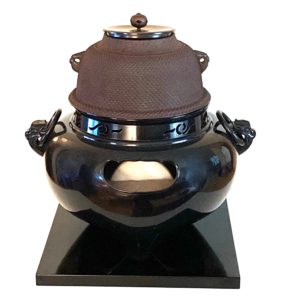
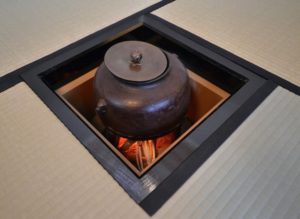
Left: kiri-kake bu-ro, 切掛風呂, cut-hang wind-hearth, bronze, supporting an iron kama, 釜, kettle: height without knob is 8 sun kujira-jaku or one shaku kane-jaku, one standard foot. Right: large kama set on a go-toku, 五徳, five-virtues, in a ro, 炉, hearth.
The kama rests on the collar of the furo. This furo was based on earlier models that were larger and used in Buddhist temples. As the furo brazier wore away, the kama was not discarded, but treasured, and used with a hearth, ro, 炉, set in the floor, where it was necessary to use a support called a go-toku, 五徳, five-virtues.
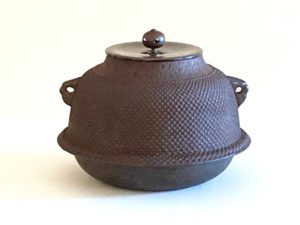
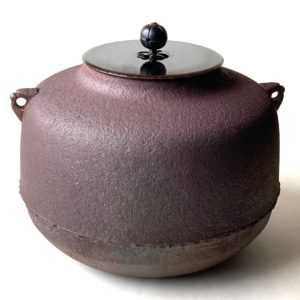
Left: shin-nari gama, 真形釜, true-form kettle, with curved hane, 羽, wing, flange, and bronze lid, for fu-ro, 風炉, wind-hearth; H. 4.7 sun kane-jaku. Right: A-mi-da-dō gama, 阿弥陀堂釜, Praise-increase-steep-hall kettle, with ha-ochi, 羽落ち, wing-drop, the hane has not been created, or fallen away, with bronze lid, for ro, 炉, hearth; H. 7.3 sun kane-jaku.
The furo kama was designed with a hane to rest on the collar of the furo, whereas the ro kama was designed to be supported by a gotoku, so that a hane was not needed.
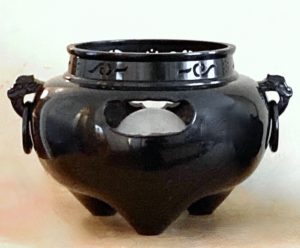
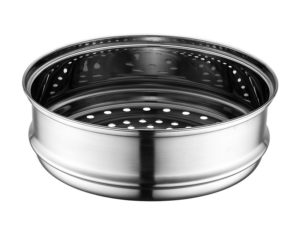
Left: fu-ro, 風炉, wind-hearth, which supported a kama, 釜, kettle, bronze: (see picture above). Right: Chinese metal zheng, 蒸, steamer.
The original kama rested on the furo’s upright collar, which is called a koshiki, 甑, (rice) steamer. The Kanji koshiki, 甑, has a complex history from ancient times in China, which became more complicated over time. In China, rice and other foods were cooked in a ceramic vessel with a perforated bottom, placed over a ceramic vessel containing water and placed over a fire. Evidence of the vessel being ceramic is found in the Kanji for koshiki, 甑, which is composed of hii, 曾, great-, on the left, and kawara, 瓦, ceramic tile, on the right.
Eventually, the perforated container became an independent steamer, such as the familiar bamboo and wood steamers in Asian cooking. In contemporary cooking, the Chinese steamer is called a zheng-guo, 蒸锅(鍋), steam-pot, in Japanese, mushi-nabe, 蒸し鍋, steam-pot. When the Chinese steamer became identified with the furo and its upright collar, holes were made in the koshiki / collar to allow air and smoke to circulate, which caused its origins to become unclear.
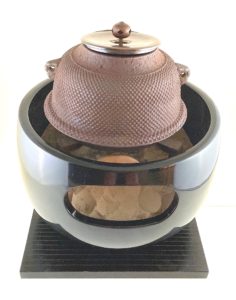
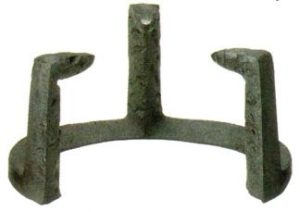

Left: kama, 釜, kettle, on a mayu bu-ro, 眉風炉, eyebrow wind-hearth, black-lacquered earthenware, placed on a ‘square’ shiki-ita, 敷板, spread-board, black-lacquered wood. Center: iron go-toku, 五徳, five-virtue, for furo. Right: sakazuki, 盃, sake cup, from I-se Jin-gū, 伊勢神宮, That-strength God-palace, used as mae-kawarake, 前土器, fore-earth-container, low-fired ceramic.
The support of the kama for Chanoyu was a go–toku, 五徳, five-virtue, which is an iron ring with three supporting pronged legs. In time, the furo was changed from a supporting vessel to an open bowl that required a device to support the kama, and the choice was a gotoku, that was smaller than that used in ro. A mae-kawarake, 前土器, fore-earth-container, is a round tile that is set upright in the ash to deflect the heat of the fire toward the kama. The mae-kawarake is aligned with the two front legs of the gotoku, and as there is no room for it, the ring of the gotoku cannot be fully round, so that it allows space for the tile. Great importance must have been attached to the use of the gotoku and its five virtues. Much of this change is credited to Sen no Rikyū.
Rikyū chose the mayu buro that was lacquered black, kuro, 黒. From all of the Tea utensils chosen by Rikyū, it is apparent that he enjoyed the color black. Shin-nuri, 真塗, true-lacquer, black lacquer with a mirror-finish, so that it might assumed that his preference was that it was like a mirror. The Kanji kuro, 黒, is also read, koku, as found in words such as Dai-koku, 大黒, Great-black, a god of good fortune and rice, also read Ō-guro. Koku means rice in specific quantities, country, etc. Other words for ‘black’ include gen, 玄, mysterious, occult, black, deep, profound, karasu, u, 烏, crow, because of its black plumage, etc.

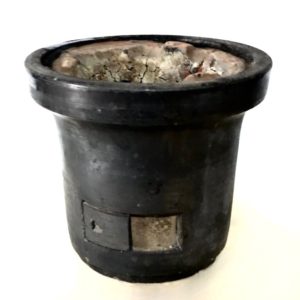
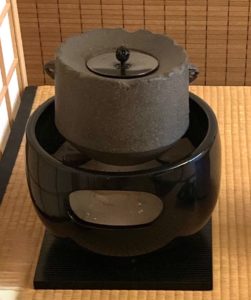
Left: do-nabe, 土鍋, earthenware-cooking pot, placed over a charcoal fire in a shichi-rin, 七輪, seven-rings, low-fired ceramic, portable brazier, its side opening is not shown. The bottom of the pot is burned black by the fire. Center: black-glazed hi-bachi, 火鉢, fire-bowl, with an opening through which the fire is fed, and a sliding door. The hibachi supports the cooking vessel directly without the use of a gotoku. Right: ya-hazu gama, 矢筈釜, kettle, over a do-buro, 土風炉, earthenware wind-hearth, which would have a charcoal fire within. Before the kama was patinated, it was originally was bright and shiny metal, that was theoretically darkened by the smoke of the fire.
The Kanji, 黒, is composed of tan, 田, field (represents earthworks holding water in ricefield, hence symbolic of water), tsuchi, 土, earth, and hi, 火, fire. Kanji, 黒, is part of the Kanji for ten, 點, offer, of ten-mae, 點前, offer-fore, which refers to the preparation and presentation of Chanoyu. The Kanji ten, 點, is composed of kuro, 黒, black, and uranau, 占, to divine. Mirrors are essential in divination. The Kanji for uranau is itself composed of another simpler Kanji for fortune-telling, boku,卜, divination, and kuchi, 口, mouth, so that divination is spoken. The Kanji uranau, 占, is composed of boku, 卜, which is composed of a horizontal line, In, 陰, negative, un-differentiated Yin and Yang, the Void, and a vertical line, Yō, 陽, positive, and kuchi, 口, which means opening and mouth, which is the source of breathing in and out, and symbolic of wind. These parts of the Kanji ten, 點, offer, represent the Go-rin, 五輪, Five-principles: Earth, Water, Fire, Wind, and Void, which are sacred to many belief systems, and are found manifest throughout Chanoyu.
Rikyū’s mayu buro (pictured above), and most hi–bachi, 火鉢, fire-bowl, had gotoku. Hibachi were rectangular and round with gotoku. The kiri-kake buro (pictured above) had been used for Tea for years. Rikyū changed the kiri-kake buro to the open mayu-buro, which required the use of the gotoku. It appears that Rikyū wanted the presence of the gotoku to be a part of the Tea presentation.
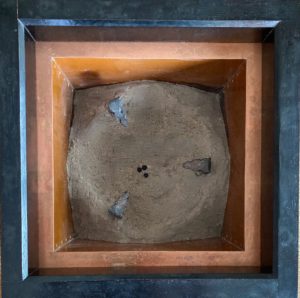
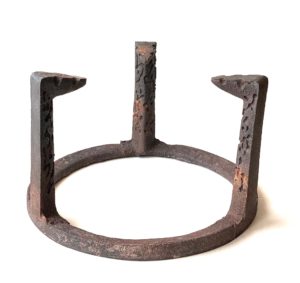
Left: the ro, 炉縁, hearth, with the go-toku, 五徳, five-virtues, revealing the three tsume, 爪, talons. Right: gotoku for ro. The picture of the ro is oriented from the teishu’s point of view.
The gotoku in the ro is situated with two tsume on the left side, and one on the right, which is called the kei-zume,檠爪, lamp-talon. This is derived from the presence of a tan-kei, 短檠, short-lamp, that would be located to the left of the ro. For certain Tea presentations, the gotoku would be set so that one tsume would be located at the back with two tsume parallel to the front, like the gotoku pictured to the right of the ro picture. This alignment is the standard for the gotoku in the furo.
When the kama was used with the ro, a device was needed to support the kama. The i-ro-ri, 囲炉裏, enclose-hearth-inner, had been in use for centuries as the source for heat and for cooking from a wood or charcoal fire, and there were various other supporting implements already in use. This included the almost ubiquitous ji-zai, 自在, self-exist, which is a wood or bamboo pole hung from the ceiling. In domestic use, it was used primarily for hanging a kettle of water.
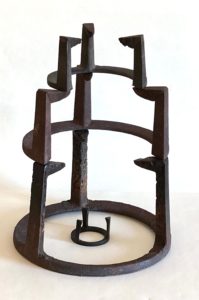
Go-toku, 五徳, fire-virtues for ben-bachi, 紅鉢, rouge-bowl, 2/3-ring diameter 4.8 sun kane-jaku, inner diameter 3.7 sun; ashi, 足, leg, H. 2/4 sun; tsume, 爪, talon, L 1.1 sun.Beni-bachi inner diameter is the same as the inner tips of the tsume of the furo gotoku.
Go-toku, 五徳, five-virtues, for fu-ro, 風炉, wind-hearth, iron; 2/3-ring diameter 6 sun kane-jaku, tsume, 爪, talon, outer ring diameter 6 sun, ashi, 足, leg, height 4.8 sun. The outer diameter of the furo gotoku is the same as the outer diameter of the tsume of the ro gotoku.
Go-toku, 五徳, for ro, iron; ring diameter 7 sun kane-jaku, tsume, 爪, talon, ring diameter 6 sun, ashi, 足, leg, height 4.8 sun.
Futa-oki, 蓋置, lid-place, Kara-kane, 唐銅, Tang-copper, bronze: ring diameter 2 sun kane-jaku, tsume diameter 1.8 sun, ashi, 足, leg h. 1.2 sun.
Four go-toku, 五徳, five-virtues: bottom, for ro, 炉, hearth, tetsu, 鉄, iron; supporting gotoku for fu-ro, 風炉, wind-hearth, iron; supporting gotoku for small furo, beni-bachi, 紅鉢, rouge-bowl, etc, iron; in center at bottom gotoku futa-oki, 蓋置, lid-place, Kara-kane, 唐銅, Tang-copper, bronze.
The furo and the ro contain a bed of ash, hai, 灰, that is made of wood, ki-bai, 木灰, wood ash. The gotoku is buried in the ash with the three legs revealed, which stresses the important of the three legs forming a kind of triangle and concealing the circular ring. Enjoying variety, the Japanese Tea masters also hung the kama above the fire with a bamboo pole and a chain. With these means there was no need of the gotoku.
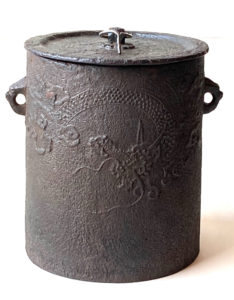
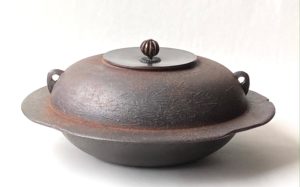
Left: Un-ryū Gama, 雲龍釜, Cloud-dragon Kettle, tetsu, 鉄, iron; height with lid 5 sun kujira-jaku: choice of Sen no Rikyū. This type of kama is most used as a tsuri-gama, 釣釜, suspend-kettle, with ro. Right: suki-gi gama, 透木釜, gap-wood kettle, iron, with wide flaring hane, 羽, wing; height excluding lid is 3.3 sun kane-jaku. Full diam. 8.8 sun kujira-jaku, diameter of the kama body is 8.8 sun kane-jaku; by Taka-hashi Kei-ten, 高橋敬典, High-bridge Respect-celebrate, Nin-gen Koku-hō, 人間国宝, Person-interval National-treasure.
The number 3.3, san-jū-san, 三十三, 3-10-3, is emblematic of the center with 32 radiances in all directions, or omnipresence, and is closely related the Kan-non Bo-satsu, 観音菩薩, See-sound Grass-buddha, the Buddhist goddess of mercy. The number 8.8 can be written hachi-jū-hachi, 八十八, 8-10-8, which can be formed into the Kanji for kome, 米, rice, which is symbolic of Infinity in Space. The surface of the kama is covered with a pattern of two-tine matsu-ba, 松葉, pine-leaf (needle), which is emblematic of simple infinity in space in one direction. This is an example of sue-hiro, 末広, ends-wide.

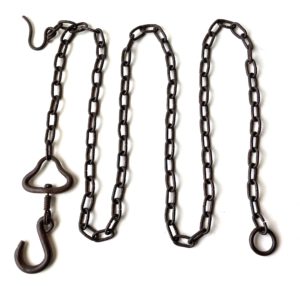
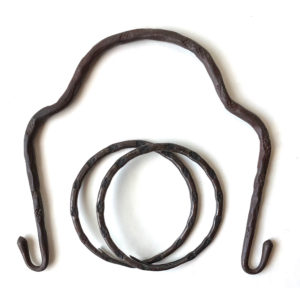
Left: take ji-zai, 竹自在, bamboo self-exist, nana-fushi go-ma dake, 七節胡麻竹, seven-nodes foreign-hemp bamboo, crepe myrtle kugi, 釘, hook, ko-zaru, 小猿, little-monkey, wedge stopper, hemp. Right above: kusari, 鎖, chain, iron, with hook and ring. Right below: tsuru, 弦, harp, and ō-kan, 大鐶, large-metal rings, steel. The chain may be likened to the rope lasso of Fu-dō, 不動, No-move, with its weight and loop to bind the sinful.
It should be understood that there are circumstances when a hanging kama or a flanged kama may be a permanent fixture in the Tearoom. It is a matter of tradition that one chooses the use of the hanging or flanged kettle. Anyone can do what they wish, provided one does not attribute it to a particular school or tradition. As a follower of a specific school of Tea, it is necessary to adhere to that school’s tradition. In March, Urasenke uses a tsuri-gama, 釣釜, suspend-kettle, and quite often the unryū-gama is the preferred choice.
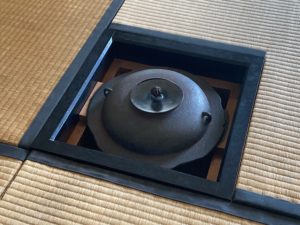
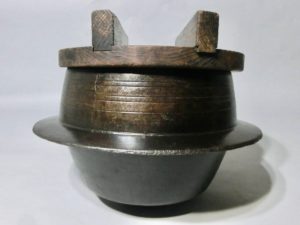
Left: kama used with the ro, called a suki-gi gama, 透木釜, gap-wood kettle. Right: meshi-gama, 飯釜, cook rice-kettle. The kama for Tea is modeled after the ancient rice cooker kettle made of ceramic or metal, pictured at right, with wide flange that rested directly on the stove, and with heavy wooden lid.
A kama with a flange is called in common vernacular, ha-gama, 羽釜, wing-kettle, which is a general term for a rice pot with a flange. When used in Chanoyu it is called a cha-gama, 茶釜, tea-kettle. Hagama molds from the 7th to the 10th centuries were excavated from the ruins in the 19th century. The flanged kama was placed directly on the kamado, 竃, stone, without the use of blocks of wood, whereas the furo with a wide shoulder does require the use of the wood blocks, suki-gi, 透木, gap-wood. The origin of the sukigi may have roots in Buddhist funeral customs.
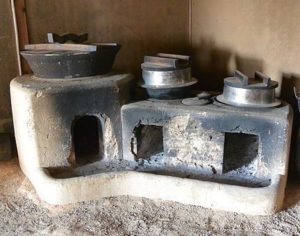
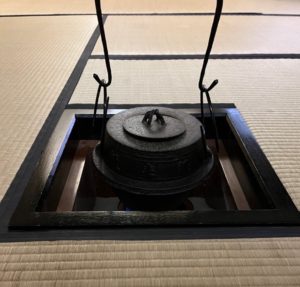
The kama pictured above is used in a Chaji at first to cook rice in the presence of the guests, and after the meal is cleaned and used to heat water for the following tea. The kama has two lids. One that spans the entire diameter of the kettle, and is used when cooking rice, and another that spans the full diameter, but has a smaller lid within it, that is used when heating water for tea (pictured). The chahan gama is also used as a sukigi gama supported on little wooden blocks.
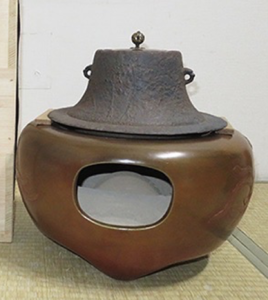
There are always variations, and one important one is the suki-gi bu-ro, 透木風炉, gap-wood wind-hearth, which has a wide shoulder to accommodate a small flanged kama that requires small sukigi for support.
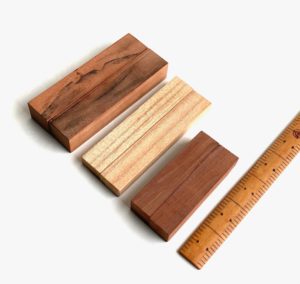
Suki-gi, 透木釜, gap-wood: left, plank for ro, sakura, 桜, cherry; ro, hinoki, 檜, cypress; plank for furo, cherry; kane-jaku mono-sashi, 曲尺物差し, bend-span thing-distinction, ruler.
According to the Urasenke tradition, in March, they use the tsuri-gama, 釣釜, suspend-kettle. The kama in suspended from a kusari, 鎖, chain, or pole made of take, 竹, bamboo, that is attached to a hiru- kugi, 蛭釘, leech-hook, in the ceiling, ten-jō, 天井, heaven-well. In April, the suki-gi gama, 透木釜, gap-wood kettle, is used, which has a wide flaring flange, hane, 羽, wing, that is rested on a pair of wooden blocks called sukigi. In both instances a gotoku is not used.
For additional study on these topics, see also: Furo and Kama Changes, Charcoal: Sumi for Furo and Ro, Tea in March, Unryū Gama, Unryū Gama – A Petal Puzzle, Unryū Gama Picture Gallery, Rikyū’sTake Jizai, and Tea in April.

